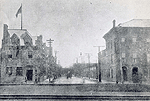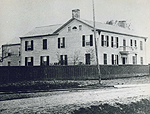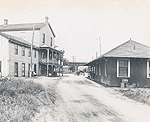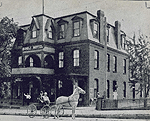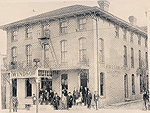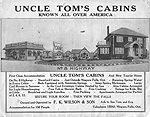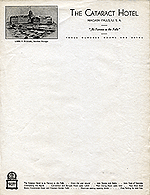In 1796, there were two hotels in Chippawa. They were the Fairbanks House built by John Fairbanks, and John Fanning’s Hotel. In 1799, Andrew Rorbach from New Jersey moved to Niagara. Here he settled on the Portage Road. Choosing a location near the mid-point between Lundy’s Lane and Queenston, he opened the Whirlpool Inn. The building is still in existence on Portage Road at Church’s Lane. In 1800, James Macklem opened his own tavern in Chippawa. It was appropriately named Macklem’s Tavern. Mr. Holder had Holder's Tavern which was located north of Ushers Creek (later spelled "Usshers"). The first hotels to appear at Niagara Falls were the famous Pavilion Hotel, the Ontario House, the Canada House and Wilson's Tavern.
The Canada House was called the “Way Farers Tavern” and stood on the front (east) lawn of the current Loretto Academy. In 1860, the Archbishop Lynch of the Roman Catholic Church from Toronto acquired from Peter Skinner (hotel owner) an extensive tract of land on which stood the old Canada House. The former Canada House building became the first Loretto Academy. Since 1820, the Ontario House owned and operated by John Brown stood on the west side of Portage Road just north of the current Loretto Academy. In November of 1834, Brown sold his hotel and property to Samuel Street. The hotel became part of the property encompassing the proposed “City of the Falls” project. From 1837 to 1838, the Ontario House was converted and used as a military barracks. The Ontario House had become the headquarters for the City of the Falls Company. The building stood until it was demolished in 1859. Wilson’s Tavern was owned and operated by Charles Wilson. He had arrived in Canada in 1788 with his wife and his children. Wilson purchased 250 acres opposite the Falls of Niagara from Francis Ellsworth. In 1797, Wilson built his tavern along the east side of Portage Road overlooking the Falls (current site of Oakes Inn). Charles Wilson died in 1813. His widow's name was Deborah Wilson. She ran the tavern following the death of her husband. She had two daughters: Harriet & Statira. James Forsyth had massed a large holding of land. He originally built the National Hotel on Portage Road near Lundy’s Lane. He later renamed the hotel, the Prospect Hotel. In 1799 sold the Prospect Hotel to John Buckner. In 1827, John Buckner sold this hotel to Harmanus Crysler. Throughout the years, the Prospect Hotel on Main Street had many other names. They included the Brick Tavern, Ellis House, and Ward's Hotel. In 1837-1838, Rebellion prisoners of war were imprisoned at the Prospect Hotel. In 1817, William Forsyth bought Wilson’s Tavern. He renamed it the Niagara Hotel. In 1821, Forsyth purchased much of the land surrounding his newly acquired hotel. Forsyth enjoyed little competition until 1820 when rival John Brown built the Ontario House Hotel. The Ontario House Hotel was also known as Brown’s Hotel. It was situated just south of Forsyth’s hotel. In 1817, the Victoria Hall Hotel was located on Victoria Avenue and the Alexandra House was located on Clifton Hill. Jim Cooper operated Knox's Tavern located at the north end of Portage Road.
In 1822, William Forsyth tore down the old Niagara Hotel and in its place built the luxurious and large Pavilion Hotel. It was built on the current site of Days Inn Overlooking the Falls (Oakes Inn). The Pavilion was a white wooden three storey structure that was the largest hotel in Niagara in Canada or America. By all standards it was luxurious and became quite famous by the many citizens and travellers. The Pavilion Hotel's many balconies provided an unparalleled view of the Falls. The Ontario House Hotel was also a white wooden three storey structure with giant white pillars at the front of the hotel. It was a smaller version of the Pavilion Hotel. It was located on the current site of the Sheraton Fallsview Hotel. In the Fall of 1826, Brown’s Ontario House Hotel burned to the ground. It was immediately rebuilt under the same name. In 1832, the City of the Falls Company rented the Pavilion Hotel for five years for a rental fee of $2,000 per year. The company also rented the Ontario House Hotel and the Red House Hotel (Prospect Hotel) to be used for their fledgling city. In 1833, the first Clifton Hotel was built at the base of Ferry Road (Clifton Hill) by Harmanus Crysler. This large hotel became the best hotel available and the flagship of all Niagara hoteliers to follow. On February 9th 1839 at 5 p.m., the Pavilion Hotel caught fire and was completely destroyed. In 1943, a new Pavilion Hotel was rebuilt however it never regained its celebrity status. On June 18th 1845, Isaiah Starkey became the new owner of the Ontario House Hotel. He renamed it the Canada House Hotel. In 1848, Adam Crysler became the owner of the Pavilion Hotel. It again burned to the ground on April 26th 1865. It was not rebuilt In 1861, the original Canada House Hotel was purchased and incorporated into the original Loretto Academy.
In 1850, the Front (Table Rock) was the location of a number of hotels. The front was the area of the current Queen Victoria Park from just north of Murray Hill to the Table Rock. They included: the Museum Hotel
In 1853, the completion of the Great Western Railway brought the first of many trains to the Village of Elgin at the Whirlpool Suspension Bridge. In 1855, the Great Western Railroad completed building a passenger deck at the site of its future depot. In order to cater to the railway passengers and tourists many hotels were built in and around the train station on Bridge Street. They included: the Elgin House
(foot of Bridge St.)
All of these hotels fell victim to fire. By 1912, the Elgin House was gone. The original Rosli Hotel had burned and was replaced by the new Rosli Hotel. The Savoy Hotel was opened at the site of Samuel Zimmerman's former bank building. The Columbia hotel had closed but was replaced by the Trennick Hotel. It was later renamed the Metropole Hotel (south-east corner Bridge St. at Erie Ave.)
In 1880, the LaFayette Hotel was built opposite the Upper Suspension Bridge just north of the Clifton Hotel. In 1885, the Niagara Falls International Camp Meeting Association opened Wesley Park (current Epworth Circle neighborhood). Wesley Park was to be a huge camp ground and summer resort. The park covered 200 acres; an area bounded by Simcoe Street, River Road, Roberts Street, and Stanley Avenue. Fifty acres of this park consisted of forest. The land was laid out in circles, crescents and streets. Nine hundred and fourteen (914) buildings were built on 50 feet wide by 100 feet deep lots. Within the large circle called Epworth there existed an auditorium to be used for Methodist camp meetings, missionary and temperance conventions. Wesley Park had its own post office and railroad stations. A staircase known as Pelly's staircase was built to the base of the gorge to allow access to the rivers edge. The camp meetings failed and the lots were sold off by lottery in 1887. In 1893, the site of the Wesley Park Camp auditorium was acquired by the Niagara Falls Collegiate Institute. In 1898, fire destroyed the Clifton Hotel. It was replaced by the new Clifton Hotel in 1905. In 1925, Howard Fox opened his famous Foxhead Inn on Clifton Hill at Falls Avenue. The Inn was a subsidiary of the Clifton Hotel. In 1926, there were very few hotels. The existing hotels included;
In the 1920's Camping became very popular. The first campgrounds were located on Highway #8 on the outskirts of the City. Campgrounds that opened included Stamford Park located at the top of Ravine Hill and Clark's Campgrounds near Stamford Center. Other campgrounds soon flourished in the city. They included: Niagara Falls Tourist Camp was opened by Charles Burland. It was located on the north side of Clifton Hill between the Foxhead Inn and the Alexandria Hotel. The camp was across from the Alexandra Hotel (site of the Park Motor Hotel). Earl McIntosh opened two campground. His Clifton Touring Camp was located on the south side of Clifton Hill on the current site of the Park Motor Hotel (Comfort Inn). McIntosh also opened his Clifton Camp located on the north side of Clifton Hill. Reinhart's Riverhurst Inn was located on the north side of Clifton Hill between the Niagara Falls Tourist Camp and the Foxhead Inn.
At Falls View there were three campgrounds:
On July 1st 1929, the General Brock Hotel located on Falls Avenue was officially opened. It became the first high rise hotel in Niagara Falls at eleven (11) storeys. It was the tallest building around. The General Brock Hotel boasted 247 bedrooms, 16 stores, 290 phones and two elevators within its 20,000 square feet. The Falls View Tourist camp was the only campground overlooking the Falls of Niagara. The only drawback to camping was outdoor plumbing. This was gradually replaced with indoor enclosed washrooms with cold and hot running water. The lack of available sanitary conditions at the campgrounds led to the development of cabin style accommodations. In 1930, George Chanady built the first of the cabins in Niagara Falls. They were located on Buchanan Avenue and were named the "Maple Leaf Cabins".
On December 31st 1932, fire once again destroyed the Clifton Hotel. Today, Niagara Falls has evolved into a world famous year round tourist destination. Niagara Falls boasts more than a hundred Hotels and motels with more than ten thousand-five hundred (10,500) rooms available.
Clifton Hotel
The original Clifton Hotel was built by Harmanus Crysler. Construction began in 1831 and it was completed in 1835. The original hotel stood three stories. It contained 60 bedrooms with accommodations for 100 people. During the American Civil War, it became a headquarters for a number of meetings between the combatants. The first proprietors of this hotel were Mr. Hulett and Mr. McKenster. They were unsuccessful in operating the hotel and after several years the hotel operations reverted back to owner Harmanus Crysler. Following a brief period of time, Crysler leased the hotel to Mr. Griffin. Over the next 30 years the hotel was operated by a number of proprietors that included: George Shears, Samuel Shears, Richard Mills, Mr. Joslyn & Mr. Dunklee, Mr. Gluck and Mr. Joslyn and finally George Colborne George Colborne operated the Clifton Hotel for thirty years from 1868 until it was destroyed by fire on June 26th 1898. Mr. Colborne was in Philadelphia at the time of the fire. The hotel manager was W. L. Ormroe. The fire started in a chimney of the boiler house near the roof of the hotel and traveled to the eves. Forty patrons escaped the fire and no one was injured. The Bender Hose Company stretched a line up to the building but the water pressure was too poor to effectively fight the fire. Flames fanned by the wind quickly spread throughout the hotel. The stone and rough cast building took the whole day to burn. Insurance amounting to $37,500 was paid to John T. Bush.
Clifton Hotel
Following the destruction of the Clifton Hotel that burned in 1898, a decision was made to rebuild immediately. The second Clifton Hotel was not completed until 1905. The new Clifton Hotel was built on the site of the former Clifton Hotel. It consisted of five stories. The new hotel cost approximately five hundred thousand ($500,000) dollars to build. It was grandiose in size and style. Following its completion, throughout the year a number of extensive renovations took place including major remodeling and building expansion. The Clifton Hotel was described as follows: The hotel main entrance was located on the south side facing Queen Victoria Park. The entrance rotunda contained a long distance phone, cable and telegraph office, a Union ticket office and a general information bureau. This elegant hotel contained parlours and writing rooms. The office was equipped with a telephone. The hotel had a spacious ballroom. Adjoining the ballroom was a Palm Room adorned with growing palm trees and other flowered plants. The Palm room was furnished with dainty chairs and tables. The hotel had a billiard room with three tables. Windows in the billiard room provided a fine view of the Falls of Niagara. A Solarium was located in the hotel with great corner chimneys and open fire places. The hotel was surrounded with cool and pleasant broad piazzas that provided panoramic views of Niagara Falls. The hotel had 270 furnished sleeping rooms. Each room was equipped with electrical light and heat, hot and cold running water, telephones, electric bells and ample bath facilities. An electric elevator took patrons from floor to floor. Inside the hotel contained elegant drawing rooms and a café to be used by both women and men guests. It provided a fine view of the Falls. The main dining room had a seating capacity for 600 people. Cuisine was of the highest caliber. There were also a number of private dining rooms, tea rooms and attractive cafes. The hotel also had a barber shop and a buffet. Luggage of American guests were received in bond and inspected at the Clifton Hotel by customs authorities. For the benefit of motor car owners, there was a parking garage operated by the hotel with a well equipped supply store. Water for the hotel was drawn from an artesian well on the premises. Ice was made by a refrigerator plant owned and operated by the hotel. Rates were $1 to $6 per day. Special rates were available for stays of a week or longer. The hotel was open all year. The manager of the Clifton Hotel was Mr. R. Major. He had previously worked for Canadian Pacific Hotels. The second Clifton Hotel was destroyed by fire on December 31st 1932. The fire was discovered by hotel caretaker, James Jones. Jones was awakened by the barking of a police dog. The fire alarm was sounded at 7:50 a.m. The fire started in the north wing in the pharmacy. It was a bright sunny day and much of the equipment was carried from the hotel into Queen Victoria Park. Everything was ready for dinner when fire broke out. Spectators who came to see the fire raided the kitchen and the wine cellar carrying off liquor and food. Stores inside the front of the hotel sustained total destruction. These stores included: Walker Drug Company, Moe Schwartz Souvenir Store, Woolevers Store, Carzo Souvenirs Store, Gray Coach Line office and a barber shop. Niagara Falls Fire Chief Baldry and his fire company battled the blaze along with two companies from Niagara Falls New York Fire Department under command of Chief George W. Wood. Much of the firefighting effort was devoted to preventing the fire from spreading to the nearby Lafayette Hotel. Fireman, William Donald sustained serious injuries when he fell twenty-two feet off the roof of the hotel kitchen. Donald suffered a concussion, scalp wounds and shoulder injuries. The loss of this fire was originally estimated at $1 million dollars and it was believed that insurance covered only $540,000. Frank A. Dudley, the secretary of the United Hotel Company estimated the hotel damage at $800,000 and the insurance coverage at $540,000. Frank A. Dudley said that the Clifton Hotel would be re-built during the following year. However, George O’Neill of the United Hotel Company later said that no decision had been made whether or not to re-build this hotel. The Clifton Hotel was never rebuilt. The property on which the Clifton Hotel had occupied was later purchased Niagara Falls businessman, Mr. Harry Oakes. Oakes had purchased the site of the Clifton Hotel and the Lafayette Hotel. Following the Clifton Hotel fire, the Hotel Lafayette located immediately to the north of the Clifton Hotel was also torn down. In 1933, Mr. Oakes traded this parcel of land (measuring 460 feet by 330 feet) to the Niagara Parks Commission for a small tract of land just above the park. The property Oakes traded for is today located along the south side of Clifton Hill. Oakes Garden Theatre was built on this site. The foundation walls of the old Clifton Hotel were included in the construction design. The Alexandria Hotel became known as the Clifton Hotel following the Clifton Hotel fire in 1932. The Alexandria was later torn down in 1964 to make way for the building of the motor hotel with forty rooms.
Hotel LaFayette operated for forty (40) years. In 1894 it was built by Harry Williams. Hotel LaFayette was five storeys in height and was built of red brick. Although the bottom four floors were of the same size, the fifth floor was about half the length of the others. Located on the north-east corner of the hotel was a six storey high circular turret which was used as an observatory. This observation tower was listed as one of the stop over points for many of the horse-drawn carriages and the later tour-cars. This observatory provided a magnificent view of the Falls of Niagara. The LaFayette Hotel was named by Mr. Williams in honour of French General, the Marquis de LaFayette. General de LaFayette aided the Americans during the American Revolution. The LaFayette Hotel boasted fifty (50) rooms with many amenities including electric lights, bells, elevator service, hot and cold running water, phone service and private or public baths. The main bottom floor consisted of a dining room, a museum and a bazaar operated by Mr. Williams and Mr. Simpson. In 1907 the room rates under the European plan cost $1 per day. Room rates under the American plan cost $2.50 per day. The LaFayette Hotel was only four years old when its neighbour, the Clifton Hotel burned to the ground. Burrell Heacock and Ignatius Roth stayed at this hotel before the 1912 fatal ice bridge accident. During the second Clifton Hotel fire, the LaFayette Hotel caught fire several times but on each occasion the fire was extinguished and the hotel saved. The LaFayette Hotel continued to operate through 1933 with an advertised forty (40) rooms. It still had three floors which had iron balconies on the front east side façade as it did when it was originally built. In 1933, Mr. Harry Oakes purchased the LaFayette Hotel. Mr. Williams auctioned off all the remaining hotel furniture. In 1934, the LaFayette Hotel was torn down and the property became part of Oakes Garden Theatre.
William Manley German was an accomplished lawyer having received the Queens Counsel designation. In 1891, he became a Member of Parliament .in the Canadian House of Commons which he promptly lost in a dispute over alleged voting irregularities. An election judge sided with former incumbent Dr. Ferguson. German under the terms of the elections act wasn’t able to run in federal politics for another seven years. William Manley German entered provincial politics becoming a member of the Ontario Legislature in 1894. German went on to serve two terms in Ontario Legislature. During this time, Manley took a most active part in battles over the monopoly rights in electric power then being waged by wealthy power interests in the USA and Canada. In 1900, German returned to federal politics when elected to the House of Commons. Here he served until 1925. In 1923, with an advance of his own money, he secured the incorporation by a private bill in the House of Commons, of the Buffalo and Fort Erie Public Bridge Company. Soon after, ample financial support was received from Buffalo and the present Peace Bridge was erected. On July 1st 1927, as vice president of this bridge company, he was given the honour of welcoming His Royal Highness, the Prince of Wales with the President of the United States for the official opening of the Peace Bridge. William German died in 1933. In 1927, William Manley German along with a group of Niagara Falls businessmen with the financial assistance of Sir Harry Oakes formed a company to build the General Brock Hotel. Mr. German secured the incorporation of the General Brock Hotel Company. The General Brock Hotel was being planned as early as 1927. Construction began in January of 1929. The hotel was built by Pigott Construction Company of Hamilton, Ontario. The General Brock Hotel was the first high rise hotel built in Niagara Falls. At eleven floors, it towered above the landscape. The hotel boasted 20,000 square feet. It contained 247 bedrooms, 50 cots, 16 stores, 290 telephones and two elevators. The top floor was reserved as the “Rainbow Room”; a glass enclosed banquet room that provided an unparalleled view of the Falls of Niagara and the Niagara Gorge. The hotel which was named after the famous War of 1812 British General, Sir Isaac Brock was officially opened on July 1st 1929. Mr. John B. Robinson was the first manager. Two additional floors were later added to the hotel by the then owners the Sheraton Hotel chain. The Sheraton Brock Hotel was sold to Mr. Arthur White in the early 1970’s. Mr. White owned the hotel until he sold it to the York Hanover Company which went on to build the Maple Leaf Village shopping complex on the former Oneida Silver Company located between the Sheraton Brock Hotel and the Sheraton Foxhead Hotel.
The main hotels in Niagara Falls, New York included:
International Hotel In 1825, the Cataract House Hotel was built. In 1853, B. F. Childs built the International Hotel at the corner of Falls Avenue at Main Street. This was the site of the Eagle Hotel that was first hotel built near the Falls. In 1878, Mr. Andrew Kaltenback opened his hotel of similar name. In 1920, this hotel was torn down to make way for the new Red Coach Inn. In 1887, Mr. David Isaacs built the Prospect Hotel. It was located on Rainbow Boulevard at 2nd Street. In the 1892 City Directory, it listed twenty-eight (28) hotels in the south part of the city and fourteen (14) hotels in the north part of the city. Notable hotels included: Hotel Imperial -
Falls Avenue at 2nd Street
In 1908, the International Hotel was sold to John F. McDonald. Interestingly, American President William McKinley had lunch at this hotel several hours before he was assassinated in Buffalo, New York. On January 3rd 1918, the International Hotel was destroyed by fire. On August 30th 1923, the Red Coach Inn opened for business. In the 1930 City Directory there were forty-seven (47) main hotels listed. They included: The Niagara Hotel
The Cataract House was located on the river bank at the corner of Main Street at Riverway. In 1825, the original part of the Cataract House was built by David Chapman on land that was originally owned by Judge Samuel DeVeaux. The three storey structure was 114 feet long and was constructed of oak logs. Not long afterwards, a narrow frame structure was added to the north side of the original building extending 100 feet. A center section being 4-5 storeys in height had a cupola that provided a commanding view of the Niagara River Rapids. In 1835, General Parkhurst Whitney purchased the hotel from Chapman. Whitney constructed a forty feet wide by fifty-six feet long – four storey addition to the hotel. Whitney renamed the hotel the “Cataract House”. In 1842 – 1843, General Whitney added another structure to the hotel almost as large as his first addition. In 1845-1846, he added yet another addition this being five storeys high measuring 152 feet by 42 feet as well as a two storey 60 feet by 25 feet kitchen. The Cataract House was the largest hotel in Niagara Falls and attracted many visitors. In 1860, the middle section of the hotel sporting the cupola was extended to the rivers edge. In the mid-1880 this section was removed when the Niagara Reservation – New York State Park was developed. In 1846, Parkhurst Whitney turned over managed of his Cataract House Hotel to his son – Major S.M.N. Whitney, and son in laws: Dexter Jerauld and J.F. Trott. During the 1880’s, Trott sold his interests in the hotel. In 1890, Jerauld died. In 1891, General Parkhurst Whitney sold the Cataract House Hotel to Peter A. Porter. In 1909, John F. MacDonald bought the Cataract House Hotel. He continued to own and operate the hotel until 1937. From 1937 until 1945, the Cataract House Hotel was owned by Union Trust Company of Rochester, New York. In 1945, the hotel was sold by the trust company to the Eagle Tavern Corporation. This corporation consisted of five local businessmen: Frank Dudley, Alpheus Phelps, Ronald Wright, James Whitworth and Henry Allen. The Eagle Tavern Corporation had plans to renovate and remodel the hotel. Unfortunately, on October 14th 1945 at 10 a.m. fire erupted in the hotel and the Cataract House Hotel burned to the ground. At the time of the fire three hundred guests and seventy-five permanent residents were forced to flee.
Date last updated:
February 13, 2012
THANK YOU FOR VISITING
a
history
|
||||||||||
